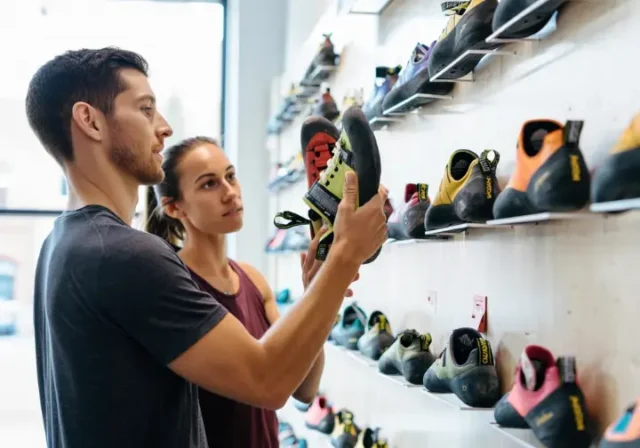In this article
Finding the right climbing shoe is like choosing the right partner for a challenging ascent – it needs to be reliable, supportive, and feel just right. This guide focuses specifically on La Sportiva climbing shoes, navigating their unique sizing system, the crucial factors defining a perfect fit (beyond just numbers), the nuances of popular models, and the fitting process itself. Let’s map out the terrain to find your ideal La Sportiva fit for rock climbing.
Understanding La Sportiva Sizing
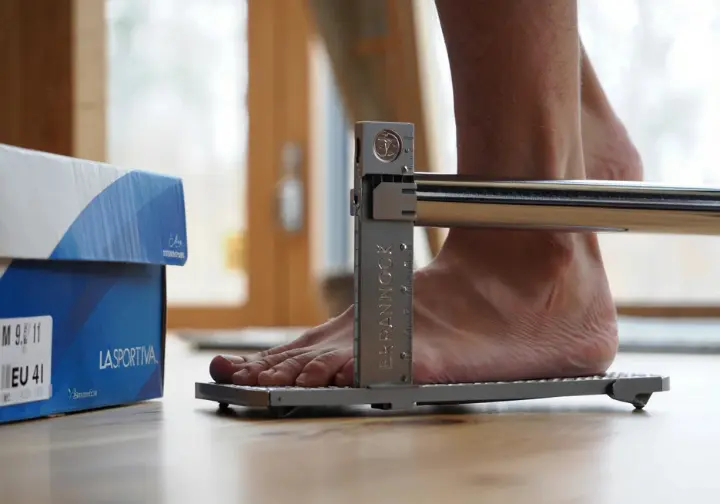
La Sportiva’s approach to sizing has nuances that set it apart. Grasping these fundamentals, like their European half-size system and the concept of downsizing, is the first step on the path to finding a shoe that performs like an extension of your foot, though variability is always part of the equation when selecting footwear.
The European Half-Size System
La Sportiva uses European sizing, which includes crucial half sizes. These offer smaller steps between sizes compared to US or UK systems. This finer scale provides more options, aiming for a more precise, dialed-in fit – think of it as having more subtle variations on a foothold to choose from.
These EU half sizes create intermediate points, often shown with a “+” on conversion charts (like US Men’s 7+ mapping to EU 39.5). This caters to feet falling between the larger gaps in standard US sizing. Correctly interpreting the official La Sportiva conversion chart is essential for translating between systems when you choose shoes.
Accurate conversion is your starting point. Always consult the brand’s official charts, which reconcile data from various sources. Slight variations can occur due to the handmade nature of the shoes, so use the chart as your primary reference for translating EU, US, and UK sizes.
The benefit? These smaller increments allow climbers to fine-tune their fit, potentially eliminating dead space or pressure points missed by broader sizing scales. This precision is vital in climbing, where finding the right climbing shoe fit directly impacts power and confidence on the rock.
When looking at size charts, focus on the specific US Men’s, Women’s, and UK equivalents for each EU half size. Avoid simple linear assumptions; the chart data provides the most accurate initial guidance for your fitting journey.
The Downsizing Dilemma Explained
A common practice in climbing is sizing down from your street shoe size for a snug, performance fit. This minimizes foot movement inside the shoe, giving you better control. However, how much to downsize with La Sportiva is where the path gets complex and personal. Many of us have learned this the hard way, ending up with shoes that either feel like sloppy buckets or medieval torture devices after a few pitches – definitely the wrong shoe for the job.
La Sportiva offers general guidelines: perhaps 2-3 EU sizes down for soft shoes, maybe only 1-2 for stiffer trad models. Treat these as rough estimates. Soft shoes rely more on toe power, hence the tighter fit suggestion, but these aren’t rigid rules. A common mistake for any climber is applying one model’s downsizing rule to another La Sportiva climbing shoe.
The ideal downsizing depends greatly on the specific La Sportiva model. Different lasts mean different fits. Recommendations vary significantly: TC Pro often sees 1-2 sizes down, Solution might be 1-3, and the soft Mantra could be 2-4. A single rule doesn’t apply across the board for these performance climbing shoes.
Your goal – performance versus comfort – heavily influences the decision. A tight fit maximizes power but reduces comfort. A comfort fit prioritizes all-day wearability, often preferred by beginners or for long multi-pitch climbs. What’s your priority on this climb?
Individual foot shape and pain tolerance are also critical. What feels perfectly snug to one climber might be unbearable for another in the exact same shoe. Listen to your body; severe pain is a sign of a poor fit, not a badge of honor. Remember that friend who insisted on crushing their feet three sizes down? They probably weren’t climbing their best, perhaps even looking like a bad climber due to discomfort.
Generic advice like “1–3 sizes down” offers a starting point but lacks model-specific detail. Always check La Sportiva’s product info and reviews for tailored insights on the specific shoe you’re considering. Downsizing guidelines help select a range to try, but the final choice comes down to how the shoe works on your foot.
Factors Defining Ideal Fit
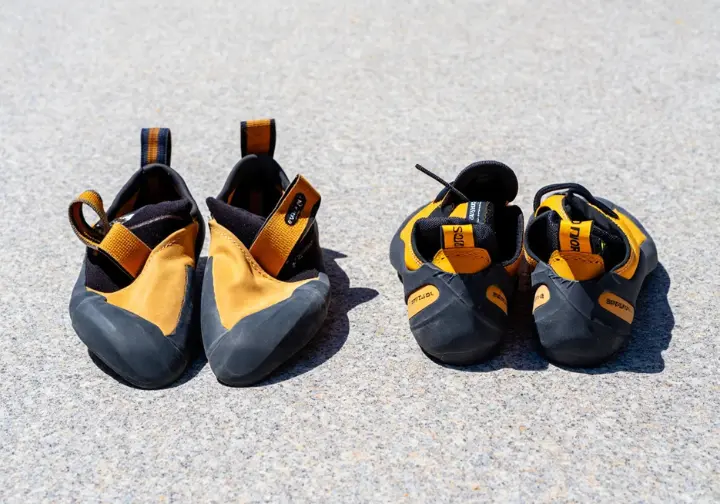
Beyond the size number, several elements shape how a La Sportiva climbing shoe truly fits and performs. Like reading a route, you need to consider the style of climbing, the shoe’s specific construction features, the materials used, and, crucially, your own unique foot anatomy.
Matching Shoe to Climbing
Your climbing discipline dictates shoe choice. Trad and multi-pitch adventures often require all-day comfort. Flatter, stiffer shoes sized less aggressively (maybe 1-2 EU sizes down) are common. Models like the TC Pro excel here, designed for crack comfort, while the Finale offers a comfortable, budget-friendly alternative.
Sport climbing demands a blend of precise edging and power for steeper sections. Moderately downturned, asymmetrical shoes are popular. Choices like the Katana Lace or Miura VS provide versatility, often sized for performance but adjusted based on personal preference and route style. These are excellent La Sportiva sport climbing shoes.
Bouldering and modern gym climbing involve steep angles and dynamic moves. Highly downturned, soft shoes, sensitive shoes shine here, grabbing holds and facilitating hooks. Models like the Solution Comp or Theory fit this mold, usually requiring a very snug fit (2-3+ sizes down) for maximum feel on minimalistic footholds.
Consider the rock type or wall features you frequent; a stiff shoe perfect for tiny edges might struggle on slopey volumes where soft shoes excel at smearing. La Sportiva offers a spectrum across their models to meet these diverse needs, whether for sandstone climbing or indoor plastic.
Beginners usually benefit from comfort and durability. Less aggressive, often entry-level climbing shoes like the Tarantulace or Finale allow focus on technique without distracting pain. These are designed with a more relaxed fit and often thicker, more durable rubber soles. Have you considered which style best suits your current climbing path?
Decoding Shoe Construction Elements
The ‘last’ is the 3D mold dictating the shoe’s internal shape, volume, asymmetry, and downturn. It’s the foundation of the fit. La Sportiva employs various lasts (e.g., PD 75 for Solution/Skwama, PD 55 for TC Pro) tailored for different feet and certain climbing styles.
‘Downturn’ is the sole’s downward curve. A downturn shoe boosts power on steep terrain (like the Solution) but reduces comfort compared to flatter shoes (like the TC Pro) that excel on slabs and in cracks. This curve significantly impacts the shoe’s feel and intended use. An aggressive downturn shoe is a specialized tool.
‘Asymmetry’ describes the curve towards the big toe, focusing power for precise edging (like the Miura VS). More symmetrical shapes offer a natural, comfortable position (like the Tarantulace). High asymmetry is typical in performance climbing shoes.
‘Stiffness’, from the midsole and rubber, affects edging support versus sensitivity. Stiffer shoes (like Katana Lace) reduce foot fatigue on micro-edges and tiny footholds. Softer shoes (like Theory) allow better rock feel and smearing capability, providing good grip.
Closure systems influence fit adjustability. Laces (Katana Lace, TC Pro) offer the most precise fit. Velcro (Miura VS, Skwama) provides quick on/off convenience. Slippers (Mantra) deliver maximum sensitivity with elastic snugness. Each system offers a different approach to securing the foot inside the climbing shoe.
Materials: Leather vs Synthetic
Unlined leather (found in Mythos, Finale, TC Pro) offers the most stretch, potentially up to a full US size. It molds exceptionally well to the foot over time, creating a custom fit. This requires a very snug initial fit but beware – it can sometimes bleed dye onto your feet! The slip-lasted La Sportiva Mythos Eco is a classic example.
Lined leather (used in parts of Miura VS, Katana Lace) significantly restricts stretch, usually limiting it to half a US size or less. This provides a more consistent fit throughout the shoe’s lifespan compared to its unlined counterpart.
Synthetic materials (like Lorica® or Microfiber in Solution, Theory) exhibit minimal stretch. The fit you feel initially is very close to the long-term fit. Synthetics help maintain the aggressive shape of performance shoes, resisting the forces that try to flatten them over time, crucial for aggressive shoes.
Many La Sportiva models use hybrid constructions, blending leather and synthetics. This balances comfort, stretch control, and performance. The overall stretch depends on the specific material placement within the shoe’s design.
Remember, stretch primarily affects width and volume as the upper conforms; the rubber sole and rand prevent significant length changes. Aggressive shoes often use synthetics or tension systems like the P3® (Permanent Power Platform) to resist stretch and maintain their performance geometry.
Understanding Your Foot Shape
Foot width is a key concern. While historically known for narrower fits, La Sportiva now offers models suiting various widths. Skwama and the slip-lasted La Sportiva Otaki are often suggested for wider feet, while Katana Lace and Miura are sometimes recommended for narrower feet, though individual experiences vary widely.
Volume refers to the foot’s 3D space. High arches or thicker feet need higher volume shoes. Low-volume (LV) or Women’s versions cater to shallower, narrower feet. Choosing the right volume prevents dead space (leading to poor performance) or excessive pressure (leading to pain).
Toe shape (Egyptian, Greek, Roman) influences toe box comfort. Highly asymmetrical, pointed shoes often suit Egyptian feet (longest big toe). Greek (second toe longest) or Roman (first few toes similar length) shapes might prefer more centered or rounded toe boxes to avoid discomfort in their climbing shoes.
Conflicting advice often appears even for specific models – the Miura VS is sometimes called narrow, sometimes wide-toed. This highlights fit subjectivity. Trying shoes on remains the best way to assess compatibility with your unique foot anatomy. Visiting a shoes shop with knowledgeable staff is invaluable.
Don’t rely solely on “wide” or “narrow” labels; consider the entire last shape – heel width and instep height – relative to your foot. A shoe might be wide in the forefoot but have a narrow heel cup that doesn’t work for you. How does your foot map compare to the shoe’s terrain?
La Sportiva Model Spotlights
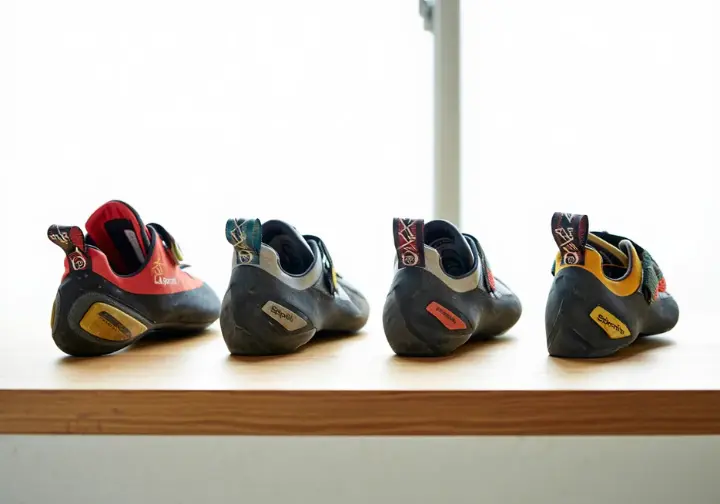
Here we delve into specific La Sportiva models, presenting them as detailed reviews based on our experiences. Each focuses on key features, performance, and fit nuances for these climbing shoes.
La Sportiva Solution & Comp
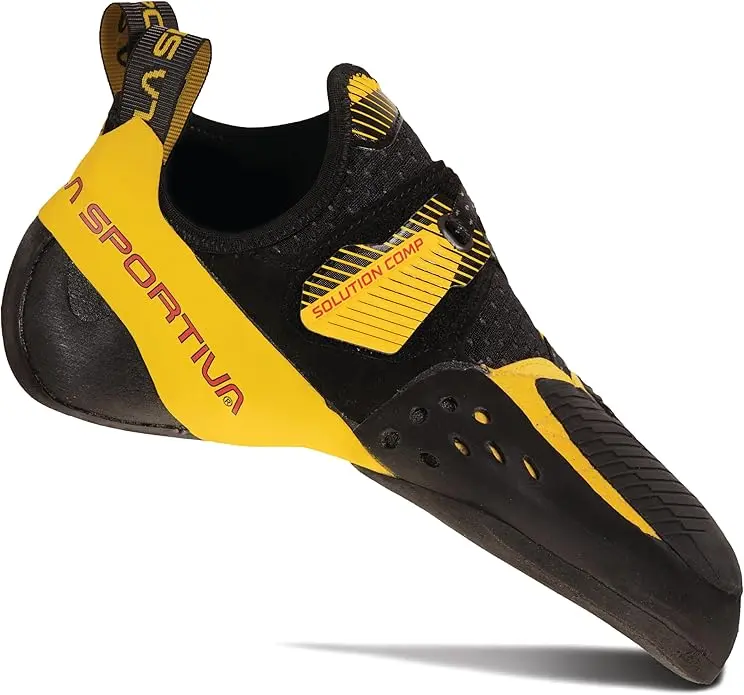
The Solution family, including the original and the softer Comp version, are aggressive tools for elite bouldering and steep sport climbing. Built on the medium-volume PD 75 last, these Solution shoes feature the P3® platform, Vibram XS Grip2 rubber, and a laser-cut leather/microfiber upper. The single-strap Fast Lacing System and enhanced toe/heel rubber (especially on the Comp) target modern hooking techniques. They weigh roughly 8.9 oz (252g) per shoe (size 39).
Sizing requires aggressive downsizing, typically 1.5-3 EU sizes below street shoes, sometimes more. The fit is precise but demands a significant break-in. While generally high quality (made in Italy), the softer Comp may wear faster, and the upper can stretch, necessitating a very tight initial fit. Some users report batch inconsistencies or heel slippage if the last doesn’t match their foot perfectly. These are pure performance shoes.
Performance-wise, these shoes offer exceptional power on steep terrain and precise hooking, with the Comp providing greater sensitivity. They excel on overhangs and competition problems but aren’t designed for all-day comfort or less-than-vertical climbing. The aggressive fit can be challenging, especially for wider feet. Trying them on is essential due to the specific last shape and potential sizing variations. The Solution Comp shoes are cutting-edge shoes for demanding climbs.
PROS
- Exceptional power on steep terrain
- Precise toe and heel hooking (especially Comp)
- P3® platform maintains aggressive shape
CONS
- Aggressive fit requires significant break-in
- Potential heel fit issues for some feet
- Sizing can be inconsistent; strap length issues possible
La Sportiva Miura VS & Lace

Renowned for edging, the Miura line (VS Velcro and Lace) uses high asymmetry and typically stiff Vibram® XS Edge™ rubber (though some have XS Grip2). The VS features a moderate downturn, P3®, and three Velcro straps, while the Lace is flatter with an unlined leather upper prone to stretching, offering maximum adjustability. They weigh around 9.5 oz (270g) per shoe (size 39).
Downsizing by 1-2 EU sizes is common. Fit perception varies: some find them narrow, others note a roomy toe box. The pointed toe excels on pockets but may not suit all foot shapes. Anticipating the Lace version’s significant stretch is crucial – start snug! Initial discomfort (especially VS) and potential strap interference in cracks (VS) are common concerns. Sizing inconsistencies between versions have also been reported.
The Miura excels at standing on tiny edges and footholds. The VS offers convenience, while the Lace provides unparalleled customization for trad/multi-pitch. Neither is ideal for pure smearing due to stiffness. Their effectiveness hinges on matching the pointed last shape. Choosing between VS and Lace depends on closure preference and managing stretch (Lace) versus seeking a consistent fit (VS). A favorite shoe for many technical climbers.
PROS
- Excellent edging performance
- Versatile (especially Lace version)
- Precise fit (VS Velcro, Lace adjustability)
CONS
- Pointed toe box doesn’t fit all feet
- Fit perception (narrow/wide) varies greatly
- Lace version stretches significantly; VS straps can interfere in cracks
La Sportiva Katana Lace

A versatile performer balancing edging power (Vibram XS Edge™ rubber, P3® in new version) with comfort, suitable for sport, trad, and gym use. It features moderate asymmetry, a slightly downturned toe (more in the updated version), and a full-length lace-up system for a customized fit. The upper blends suede leather and microfiber for durability with limited stretch (around half a size). Weighs approx. 8.8 oz (250g) per shoe (size 39).
Known for a precise, relatively narrow fit, especially in the heel. Typically sized 1-1.5 EU sizes down. Crucially, the updated version fits larger than the original, often requiring an extra half-size down – a common fitting mistake is not accounting for this generational change. It requires some break-in, and the stiffness reduces sensitivity compared to softer shoes.
The Katana Lace shines on technical face climbing and edging, making it a reliable all-arounder for intermediate to advanced climbers. Potential issues include the newer version feeling stiffer, the pointy toe not suiting wider feet, and laces wearing in cracks. Verifying the version (old vs. new) is essential due to sizing differences. A truly progressive shoe.
PROS
- Excellent balance of edging and comfort
- Highly versatile across disciplines
- Precise lace-up fit
CONS
- Significant sizing difference between old and new versions
- Relatively narrow fit may not suit wide feet
- Less sensitive than softer bouldering shoes; laces can wear
La Sportiva TC Pro
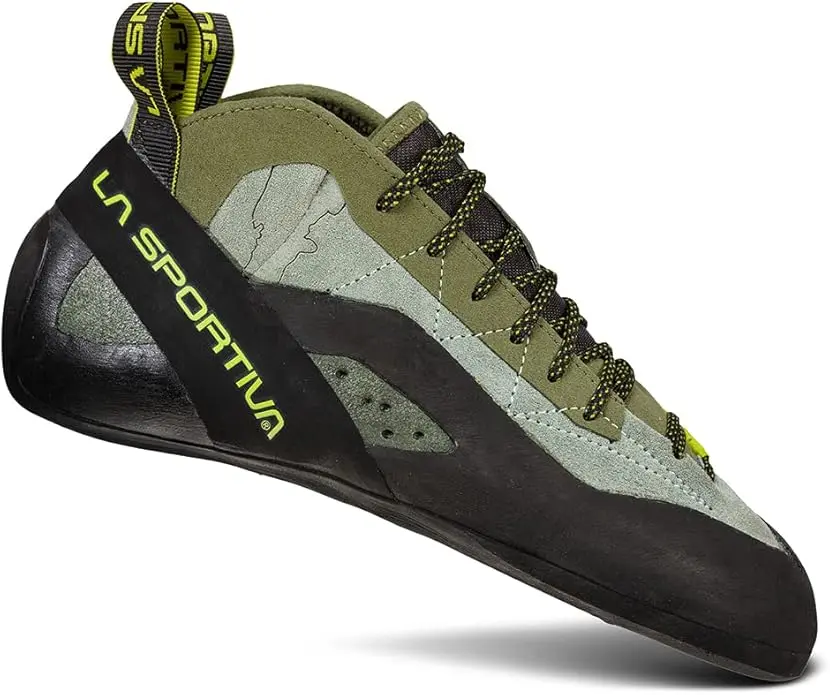
The benchmark for demanding trad, crack climbing, and all-day multi-pitch comfort, designed with Tommy Caldwell. Features a flat profile ideal for jamming, a stiff P3® midsole with Vibram XS Edge™ rubber for support, high-top ankle protection, and a padded tongue. Built on the supportive medium-volume PD 55 last, weighing approx. 8.7 oz (247g) per shoe (size 39). The slip-lasted La Sportiva TC Extreme shares some heritage but is geared towards colder conditions.
The unlined leather upper molds with minimal stretch (up to half size). Sizing advice is notoriously inconsistent: recommendations range from street size (for comfort/socks) to 1-2+ EU sizes down (for performance). Significant sizing variations between production runs and even pairs are widely reported, making trying them on essential. A break-in period is needed.
Its performance in cracks (especially hand sizes and larger) and on granite edges is legendary. The ankle protection is invaluable. However, the flat profile is less suited for very steep terrain, and the primary challenge is navigating potential sizing inconsistencies. It’s a specialized tool requiring careful fitting, often considered essential climbing gear for mountains involving cracks.
PROS
- Benchmark for crack climbing comfort and performance
- Excellent edging support and ankle protection
- Durable construction for demanding use
CONS
- Significant sizing inconsistencies reported
- Flat profile less ideal for very steep climbing
- Requires break-in; can feel bulky initially
La Sportiva Finale
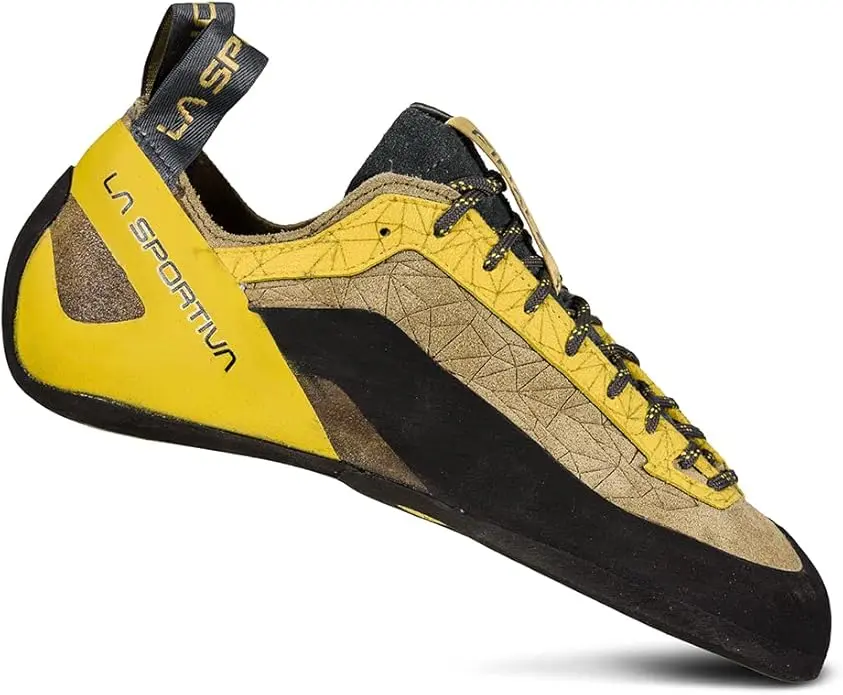
A comfortable, durable shoe for moderate routes, all-day wear, and beginner-to-intermediate climbers. Features an unlined suede leather upper (with 40% eco-components), durable 5mm Vibram XS Edge rubber, and a full-length LaSpoFlex midsole for support with a neutral-to-slight downturn. Weighs approx. 8.4 oz (240g) per shoe (size 39). This is the slip-lasted La Sportiva Finale.
Offers a forgiving, medium-width fit suitable for various foot shapes, prioritizing comfort. Sizing is typically close to street shoe size or down 0.5 EU size for a tighter fit. The leather molds with minimal stretch. The thick rubber provides durability but less sensitivity than thinner soles. Some users note the orange leather version can initially stain heels.
The Finale provides reliable edging for moderate grades (e.g., 5.7-5.10) and excellent comfort for long gym sessions or multi-pitch routes. It’s a versatile and eco-conscious choice, balancing performance and comfort without aggressive features. Less suited for advanced edging or smearing compared to more technical models. A good option for those starting lead climbing.
PROS
- Excellent all-day comfort, great for beginners/long sessions
- Durable construction with thick rubber
- Versatile for moderate gym/outdoor routes; includes eco-components
CONS
- Limited sensitivity for advanced climbing/smearing
- Less precise edging than technical models
- Orange leather version may stain heels initially
La Sportiva Tarantula Boulder

An entry-level climbing shoe focused on comfort, affordability, and features tailored for bouldering and gym climbing. Uses an unlined leather upper, FriXion RS rubber (5mm) on a half-sole for sensitivity, and a dual hook-and-loop closure. Enhanced heel and toe rubber improve hooking compared to the original Tarantula. Weighs approx. 8.5 oz (240g) per shoe (size 39).
Features a wide, rounded, high-volume fit suitable for many beginners or those with wider feet. Runs large, typically requiring sizing down 1 full EU size from street shoes. The leather molds slightly, and the Velcro offers quick on/off. The half-sole increases flexibility but may impact longevity for some users.
Designed for comfort and ease of use on moderate problems (up to V5). The hooking features are a plus for bouldering. However, significant user reports mention durability issues, specifically the sole or toe rubber detaching prematurely. Quality control inconsistencies (glue, seams) have also been noted. It lacks the precision needed for advanced routes or tiny footholds.
PROS
- Exceptional comfort, especially for beginners/wider feet
- Affordable entry-level price point
- Enhanced hooking features for bouldering; easy Velcro closure
CONS
- Significant durability concerns (sole/rubber detachment reported)
- Runs large, requiring careful sizing down
- Lacks precision/sensitivity for advanced climbing; quality control issues noted
La Sportiva Kubo
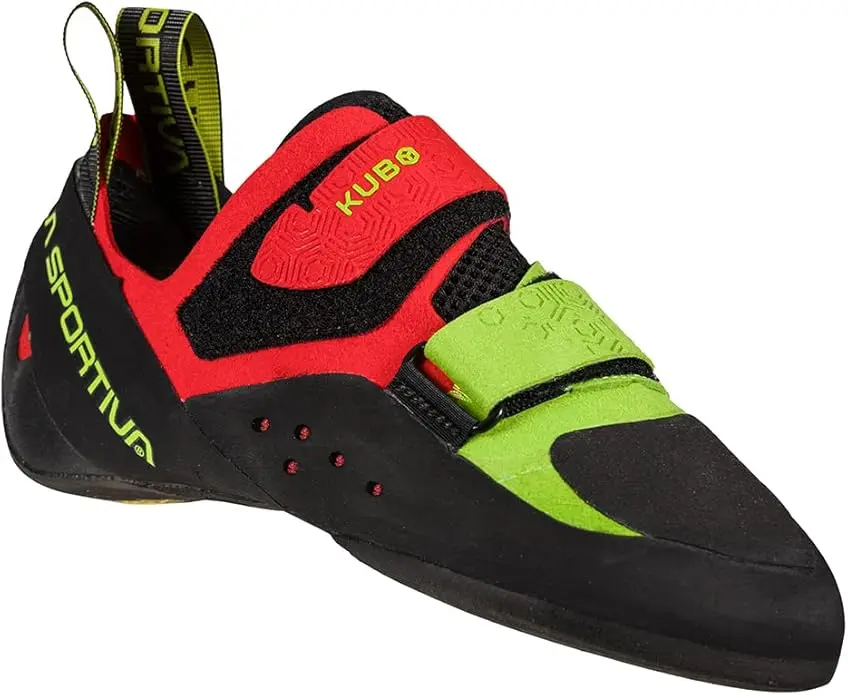
A versatile intermediate shoe bridging beginner comfort and performance features, suitable for indoor bouldering, lead climbing, and moderate outdoor routes. Features an unlined microfiber/suede upper, Vibram XS Edge rubber (4mm) on a three-quarter sole, and an integrated heel/toe patch (XS Grip2) for hooking. Uses an opposing dual hook-and-loop closure. Weighs approx. 7.1 oz (200g) per shoe (size 39).
Offers a comfortable fit for narrow-to-medium feet with a moderate downturn and medium-soft flexibility, good for volumes and varied terrain. Runs small, often requiring sizing near street shoe or down 0.5-1 EU size for performance. Minimal stretch. Some users report issues with Velcro durability (unstitching).
Provides a good balance of comfort, edging (XS Edge), and hooking for climbers progressing into intermediate grades (V2-V6 / 5.8-5.11). The three-quarter sole enhances flexibility but might wear faster than a full sole. Potential production errors (uneven rubber, stitching) and Velcro issues are drawbacks to watch for. A good shoe for athletes moving up.
PROS
- Good balance of comfort and intermediate performance
- Versatile for gym/moderate outdoor routes (V2-V6)
- Precise hooking features; sticky rubber grip
CONS
- Runs small, sizing can be inconsistent
- Velcro durability issues reported by some users
- Potential for production errors; less durable than full-sole shoes
Fitting Process & Break-In

Navigating the final steps – trying shoes on and managing the break-in period – is where you confirm your choice. This hands-on (or rather, feet-on) phase solidifies the connection between climber and shoe.
Trying Shoes On Effectively
Try multiple models and sizes, including those crucial half sizes. Compare fits directly, especially given potential inconsistencies. Don’t anchor yourself to just one option before exploring. I once watched a climber spend an hour convinced only one model would work, only to find a perfect fit in something unexpected after finally trying other options at the shoes shop.
Aim to try shoes later in the day. Feet naturally swell slightly, mimicking conditions during a climbing session. This helps avoid selecting a size that feels fine initially but becomes painfully tight after warming up.
Assess fit barefoot unless you always climb with socks. If you use socks, bring the exact pair you’ll wear. Most climbers opt for barefoot to maximize sensitivity and feel for the rock, especially on small slopey footholds.
If possible, test the shoes on small edges or a climbing wall in the shop. Stand on your toes – does the heel lift significantly? Feel how the shoe supports your foot under pressure, assessing the sole thickness and stiffness. This simulates real-world use better than just walking around.
Check carefully for dead space. Pay attention to the heel cup (it should be snug with minimal lift) and around or above the toes. A performance fit aims to eliminate empty areas where your foot could shift.
Ensure your toes reach the end of the shoe. They might be flat (comfort fit) or slightly curled (performance fit), but they shouldn’t be painfully jammed or crushed against the rand. Secure the closures properly to prevent internal foot movement. How does the pressure feel across your entire foot?
Finding the right balance between a snug performance fit and acceptable comfort is the goal. Avoid excruciating pain – it signals a poor fit or excessive downsizing, hindering rather than helping your climbing. The right shoe makes climbing better, a bad shoe makes it miserable.
Navigating the Break-In Period
Most new climbing shoes need a break-in period, typically 3-5 climbing sessions, as materials stretch and mold. Expect some initial discomfort, but not severe pain. This is the shoe adapting to your foot’s unique contours.
Leather shoes stretch more (up to a full size potentially) than synthetics (minimal stretch). Unlined leather offers the most adaptation, while lined leather provides a middle ground. Knowing the material helps anticipate how much the fit might change.
The best break-in method? Climb easy routes. Natural foot movement shapes the shoe effectively. Wearing them for short periods at home while sitting can also help assess fit comfort without prematurely wearing down the rubber.
Take the shoes off frequently between climbs during the first few sessions. This relieves pressure and allows the materials (and your feet) to adapt gradually. A thin plastic bag over your foot can sometimes help ease very tight shoes on initially.
Less conventional methods exist (heating, showering, freezing) but carry risks of damaging glue or materials. Gradual wear through climbing is generally safer and more effective for achieving a truly personalized fit. We’ve all heard stories of ruined shoes from overly aggressive break-in tactics!
Break-in involves both the shoe stretching and your foot adapting. Experienced climbers’ feet are often more conditioned to tighter fits. Be patient with the process; a well-broken-in shoe feels significantly better than a brand-new one.
Conclusion: Your Best Fit
Choosing the right shoe from the La Sportiva climbing shoes lineup is a personal expedition. It requires understanding their unique sizing system, carefully matching the shoe’s design – its last, downturn, asymmetry, and materials – to your specific climbing style and, most importantly, your individual foot shape. Remember that reported sizing inconsistencies, especially between model generations or even pairs, make trying before buying invaluable.
Assess your primary climbing needs. Research specific models using La Sportiva’s resources and trusted reviews. Use sizing charts and downsizing guidelines as a starting point, not a final destination. Prioritize the actual fit on your foot above all else. Visit a knowledgeable retailer or shoes shop, try on multiple sizes and models, and test them if you can. Anticipate the break-in period, particularly with leather. Finding that perfect fit might take some trial and error, but the connection you’ll feel with the rock in the right climbing shoe makes the journey worthwhile.
Frequently Asked Questions
How much should I really downsize La Sportiva shoes? >
Do La Sportiva shoes fit narrow or wide feet? >
How long does it take to break in La Sportiva shoes? >
What’s the difference between Men’s and Women’s/LV versions? >
We are a participant in the Amazon Services LLC Associates Program, an affiliate advertising program designed to provide a means for sites to earn advertising fees by advertising and linking to Amazon.com. As an Amazon Associate I earn from qualifying purchases. We also participate in other affiliate programs. The information provided on this website is provided for entertainment purposes only. We make no representations or warranties of any kind, expressed or implied, about the completeness, accuracy, adequacy, legality, usefulness, reliability, suitability, or availability of the information, or about anything else. Any reliance you place on the information is therefore strictly at your own risk. Additional terms are found in the terms of service.



